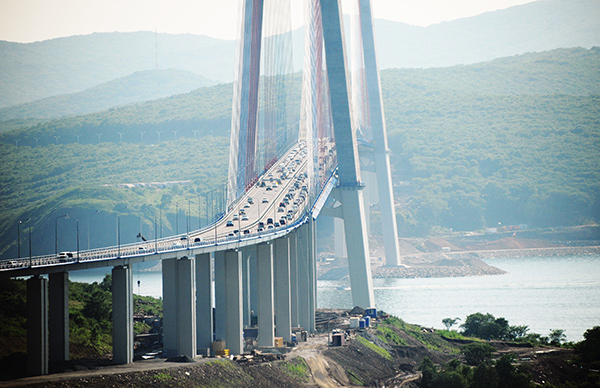
The Russky Bridge is a bridge built across the Eastern Bosphorus strait, to serve the Asia-Pacific Economic Cooperation that took place in Vladivostok in 2012. The bridge connects the mainland part of the city (Nazimov peninsula) with Russky Island, where the main activities of the summit are to take place. The bridge was completed in July 2012 and opened by Russian Prime Minister Dmitry Medvedev. On September 3, 2012, the bridge was officially given its name.

The bridge to the Russky island is the world’s largest cable-stayed bridge, the 1104 m long central span of which has established a new record in the world bridge building practice.
The bridge will also have the second highest pylons after the Millau Viaduct and the longest cable stays.
The design of the bridge crossing has been determined on the basis of two primary factors:
Shortest coast-to-coast distance in the bridge crossing location 1460 m. Navigable channel depth is up to 50 m.
The locality of the bridge crossing construction site is characterized by severe climate conditions: temperatures vary from -31°C to 37°C, storm wind velocity of up to 36 m/s, storm wave height of up to 6 m, ice formation in winter of up to 70 cm thick.

Bridge footprint: 60+72+3×84+1104+3×84+72+60 m
Total bridge length: 1885.53 m
Total length incl. trestles: 3100 m
Central channel span length: 1104 m
Bridge width: 29.5 m
Bridge roadway breadth: 23.8 m
Number of driving lanes: 4 (two in each direction)
Under clearance: 70 m
Number of bridge towers: 2
Pylons’ height: 320.9 m
Number of cable stays: 168
Longest / shortest cable stay: 579.83/135.771 m
The island, which in Soviet times was closed to the public due to a number of military facilities, has become a major center for international cooperation among APEC economies. To do this on the island in 2010 established tourist and recreation economic zone (now Russia has a total of 8 of these areas). On the Russian are building an international business center, hotel, research facilities, RAS, okeanirum and a number of other structures. Most of the area after the summit will serve as the campus of the Far Eastern Federal University. In Vladivostok, will be hosted by a number of venues that will be home to a bus links directly to the university campus.
At the bridge there were many critics. Many wondered why the building is so expensive and complicated construction to connect the mainland with the island area of ​​about 100 square meters. km and has a population, according to various estimates, from 3000 to 5000.
In this capacity of the new bridge – 50,000 vehicles per day. Before the revolution, the island is home to about 25,000 people, but since then its population has steadily declined. Because of the large-scale construction projects that unfolded on the island, several hundred Russian inhabitants were relocated.
The piles will be driven as deep as 77 m below ground, and on the island side the 120 auger piles will be piled under each of the two 320-m high bridge towers.
The pylons will be concreted using custom self-climbing forms in pours of 4.5 m. A crane will be used on the first three pours, afterwards the formwork will start unaided moving through the hydraulic motion of modular elements.
The pylons will be A-shaped, therefore, the use of standard forms will not be feasible. An individual set of forms has been arranged for each bridge tower.
Transition between section types will be carried out at summer levels at the elevations of 66.26 m and 191.48 m.
The use of self-climbing forms will make it possible to achieve better quality and decrease the time of construction of cast-in-situ reinforced concrete structures by half as much again.
Cable stays anchorage zone starts at the elevation of 197.5 m. The installation of cable stay pairs and casting of bridge tower bodies will be carried out simultaneously, dramatically reducing the construction period.
See also: Bridges photos collection